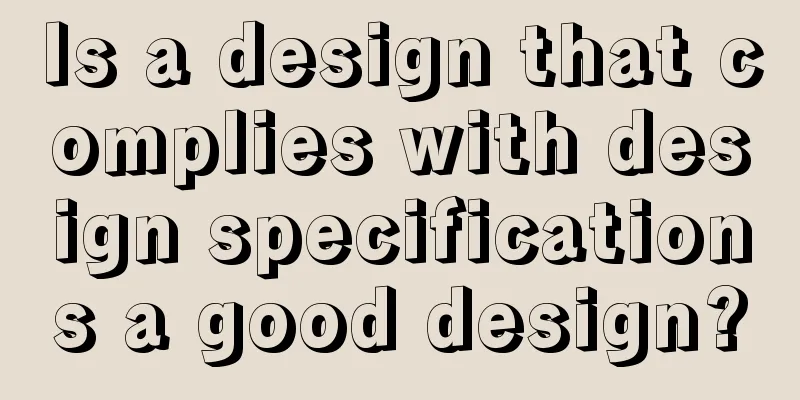Is a design that complies with design specifications a good design?

|
In the past few years of my career, I have written and consulted on quite a few so-called "design specifications". This is probably what the decision-makers in China think of it: a group of farmers grow crops in a field. At first, the weather is good and the land is fertile, but soon the weather gets worse, there are more insects, the land is seriously desertified, and there are a few stupid traitors who steal the crops. Now a specification must be established, and the leader tells them where to plant, how much wheat to harvest, which part of the land to keep for the next season, what kind of wheat to grow to give bonuses, and how to deal with those who are lazy and don't work... But the specification as I understand it is not to simply make a design into a quantitative indicator of "industry routine", but a reference for comprehensive quality evaluation, or even a determining factor in whether a design can be launched on the market. To do this, we need to draw up some forms, document filings, graphic references, and interaction templates. At the same time, design specifications should also become the common values of a design department or a company regarding design quality, so that everyone knows that a good design is produced in this way. Through such standardized education and communication, a unified understanding of design quality can be formed. Design specifications do not dictate what should be done, but rather suggest that doing something is correct, but there are areas where it can be improved. Foreign designers call this approach a design tool, which is a template application method (stencil). We call it a specification, which is more inclined to regulation, but we only learn the simple part of quantitative indicators. To put it more seriously, we Chinese have always been very good at creating a framework (a tight hoop) for ourselves to constrain our actions and thoughts. There may be three reasons:
We turned a tool into an institution from the very beginning, and that's when problems arose. For a design team in its growth stage, establishing design standards requires establishing a set of available tools, and then developing them into a road map for the department's design quality construction based on the tools. If you just make a standard like "the spacing between navigation buttons must not exceed 10px", it's like when you were a child, you had to hear a "hush~~~~" sound when you peed, which made you pee faster. I am not talking nonsense here. In my opinion, there are not many excellent design specifications that can be seen and touched in our industry now. Let me talk about it now and share it with you: 1. Reasons why design specifications fail to achieve the expected results <br />Specs are always drafted and modified only after problems and errors occur, which lacks foresight; After the standards are formulated, they are not fully implemented, lack strength and reward and punishment measures, and the pace of supervision and control is slow; During the product design process, no further revisions to the design specifications are made, and even previous errors are not corrected; Designing completely according to design specifications dogmatically. For example, some teams still use general design specifications, and many designers repeatedly design similar pages, similar advertisements, and similar animations according to the requirements. They are completely featureless and undifferentiated. - If you pay attention, you can see how similar the various Internet products are now? I have to say that those poor design specifications bear some responsibility. 2. The most common mistake in design specifications <br />Let department leaders formulate design specifications - Design specifications are developed through joint discussions and improved and revised during iterations. Since most domestic designers have "leadership phobia", such specifications are just empty promises even if they are formulated. There are even many leaders who rarely participate in front-line work. Copying the design specifications of successful foreign teams - This mostly happens in design teams that like to "use foreign things for Chinese purposes". The design environment at home and abroad is very different, the products are very different, and the markets they face are also very different, so don't copy them, and don't translate them directly. Print out the design specifications and stick them next to your seat - is this a "big-character poster" or a "show of determination"? For the designer friends I know, there are only two things they often look at next to their seats: one is the calendar, and the other is to check whether the mobile phone battery is full. 3. The essence of design specifications is to do a good job as a human being .<br />In my opinion, as long as Chinese companies have a design department, the most important thing when developing design specifications is to tie it together with corporate management and team culture building, and do the work of human development and construction. To be honest, our designers are not that mature and have not had much design training. The existence of bad specifications will only make designers more reluctant to communicate - "What is there to talk about? Aren't there specifications? Just follow them." If the design department really communicates closely and has common values during the design process, the design process will go smoothly and a "norm" will be formed naturally, which does not require too much text description. I have also seen some companies’ design specifications clearly stating: “Once the above-mentioned AC problems occur during the design and production, the designer’s personal evaluation will be deducted 5 points.” OMG, it turns out that your product is only worth 5 points. 4. What are the goals of excellent design specifications? Quantitative indicators: Identify general usability principles and aesthetic common sense to avoid making mistakes, and how to remedy them if they occur. The first purpose of the specification is to reduce the number of errors in the design process. This is generally aimed at novice designers. A good quantitative indicator is to tell them experience. For example, it is recommended to do at least 2 tests with different resolutions in ie6, ie7, firefox, and safari after the HTML file is output, and add the results to the "Design Specifications-Reference Data"; rather than prescribing directions for him, such as: conducting tests and modifications according to the requirements of the product department. Confirm the key design points: Obtain key points within the scope of the design specification, including design direction and design elements, to achieve closer coordination among team members through the project design process. It is a test document that records errors in the process and keeps them as experience for future use. Here, milestones for project and product design can be made. Standard design principles: This principle may be for a single project or it may be the guiding principle for the entire design team. This principle should be emphasized and implemented repeatedly, and team members should be jointly responsible for this principle, such as: "Ensure that the design output is completed 4 hours before the end of any project", "Never allow the design of a rough interface solution, as shown in the figure below: XXXXX", etc. The design specifications themselves also need to be usable: To describe the same design requirement, you could say: "The S-level designer will work on the phase 1 part of the project, with a controllable time of no more than 2.5 cycles, and the output will be subject to ISO000459 procedure review"; but with this description, more people will understand: "Interface designer XXX will design a high-fidelity prototype of the project interface, which must be completed within 10 working days and reviewed in Conference Room 5 at 14:00 on May 22nd." Never complicate things. People who can make things simple are great, and the same goes for design standards. |
<<: A few things you need to know about responsive layout
Recommend
js to implement file upload style details
Table of contents 1. Overview 2. Parameters for c...
Tips for writing concise React components
Table of contents Avoid using the spread operator...
Analysis of Nginx Rewrite usage scenarios and configuration methods
Nginx Rewrite usage scenarios 1. URL address jump...
Introduction to HTML page source code layout_Powernode Java Academy
Introduction to HTML page source code layout This...
Detailed analysis of Vue child components and parent components
Table of contents 1. Parent components and child ...
Modify the boot time of grub in ubuntu
The online search to modify the grub startup time...
Detailed explanation of the relationship between the primary key being 0 and the primary key self-selection constraint in MySQL (details)
Preface This article mainly introduces the relati...
Analysis of the difference between placing on and where in MySQL query conditions
Introduction When writing SQL today, I encountere...
Detailed explanation of the interaction between React Native and IOS
Table of contents Prerequisites RN passes value t...
Use pure CSS to disable the a tag in HTML without JavaScript
In fact, this problem has already popped up when I...
jQuery implements percentage scoring progress bar
This article shares the specific code of jquery t...
How to use MySQL's geometry type to handle longitude and latitude distance problems
Create a table CREATE TABLE `map` ( `id` int(11) ...
Implementation example of Docker deployment of front-end and back-end separation projects
Table of contents 1. Environmental Preparation 2....
Basic operation tutorial of files and permissions in centos
Preface Before we begin, we should briefly unders...
Installation tutorial of mysql 8.0.11 compressed version under win10
This article shares the installation tutorial of ...









